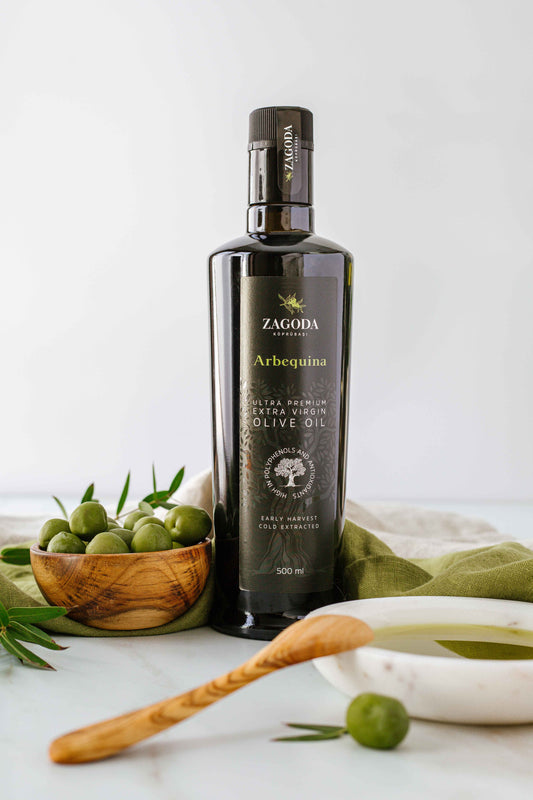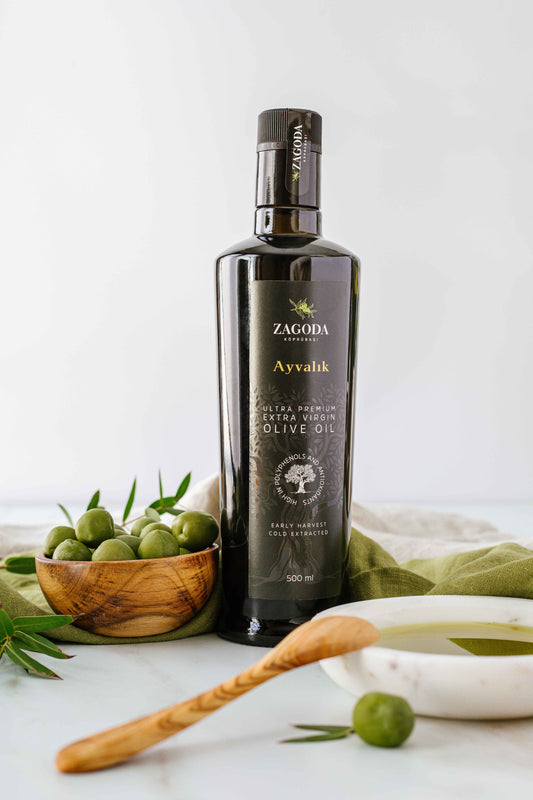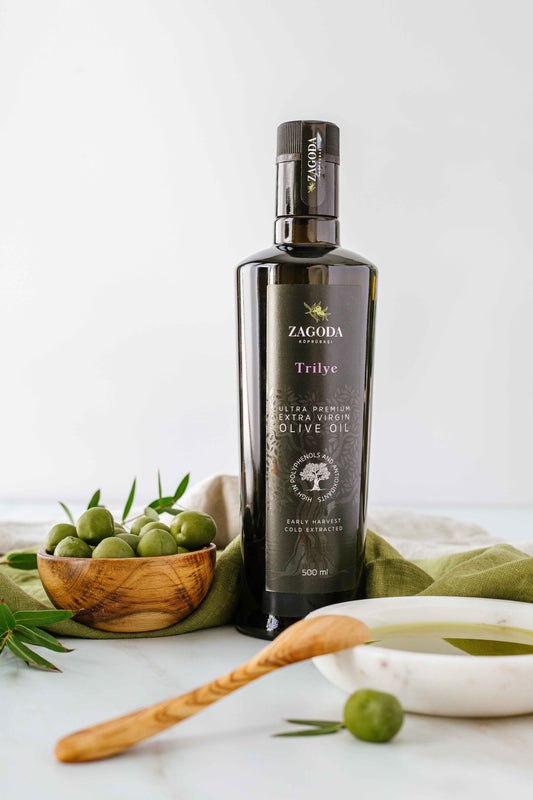How do I know if olive oil is real? You are looking for an answer to this query. So we are here to answer your questions. You should have to make sure that you are purchasing the olive oil from the right brand. It is better to the health of you. Now in market many sellers sell olive oil which is not purely extracted from olives.
In this blog, we'll provide you with a few simple methods to check if the olive oil you're using is genuine. You will learn how to recognize olive oil by reading labels performing easy tests at home, and tasting its true flavor and health benefits. Otherwise, we are providing you with the best pure olive oil for your daily cooking use. Our best-selling product Arbequina Extra Virgin Oil (Limited Quantity Available) is purely extracted from pure olives. We guarantee you a pure olive oil, make sure to buy it from our store.
Is olive oil "fake" in any way?
Olive oil is just the liquid that has been extracted from raw olives no additional processing, heat, or chemicals are added. The International Olive Council located in Madrid requires the oil to pass sensory evaluations and laboratory investigation to be classified as extra-virgin the highest grade.
There are numerous potential for fraud in the industrial process. since the majority of olive oil produced in one nation is exported to another. It is blended with olive oils from other countries before being bottled and shipped to other locations.
It is combined with imitation extra virgin olive oil or thinned with inexpensive soybean or seed oil after being chemically processed. But by the time it hits the shelves the bottle is poor. It has lost some of its amazing health benefits and doesn't meet IOC regulations.
How Do You Know If Olive Oil Is Real or Fake?
Olive oil can often be mixed with inexpensive soybean oil or old olive oil that has been in the store for more than a year. Although this procedure is lawful con artists are not permitted anyplace. By the time this adulterated or fraudulent olive oil reaches the final customer, its quality has declined to the point where its health benefits are no longer as great.
You can find out if the oil is real or fake by using the techniques mentioned below. Although the deduction is not entirely accurate it will nonetheless be useful to you in this field. A common question is, "How do I know if olive oil is real?" Just simply looking at the bottle does not always reveal the answer. Here are few steps by which you can make sure that this Olive Oil is real:
- Verify the name of the company, the mill, and the harvest date.
- Verify if the mill is legit and registered. Please check the extra certification labels on the bottle. If the bottle indicates that it was made in a large city, it is safe to buy. Put your trust in your senses.
- Never purchase olive oil just because it is expensive or comes in a nice container.
- Take special note of these points.
- If you observe that the bottle is missing any of them.
- Before making a purchase check online for extra information or read customer reviews if there is anything fresh.
Visit our website to explore best-selling natural items and reviews that are all organic. Our olive oil is the no 1 online selling brand in the world.
How Does a Good Olive Oil Look Like?
The thing to bear in mind is that olive oil has fruit qualities because it is produced from olive fruit. The following are salient characteristics of high-quality, fresh olive oil:
- It has a brilliant green hue. Since it's fruit extract it needs to taste light and fresh rather than thick like other oils.
- Olives have a bitter flavor. Ripe ones will have a richer flavor. Thus bitter olive oil indicates high-quality oil.
- The spicy, peppery flavor is another noteworthy aspect. You will taste its strong flavor when you swallow it. Likewise, this trait suggests the existence of antioxidants, which are very beneficial to the heart.
How Can You Tell Whether It's 100% Extra Virgin Olive Oil?
Most imitation olive oils include some olive oil. It is, nevertheless, combined with other oils, such as vegetable oil. This lowers the cost of manufacturing, but it may not lower the final price for you.
Here we give you some suggestions to check the olive oil,
1: Harvest Time
Harvest dates are printed on bottles of premium authentic extra virgin olive oil. This doesn't tell you much on its own. It shows that the oil you are viewing is made by a reliable producer. An olive oil harvest that occurred within the last 18 months is preferable because fresh olive oil is usually superior.
To put it briefly they are being open and honest about the product; an ingredients list will be provided, and it shouldn't include extra oils. You can make an informed decision thanks to the additional information which shows that they are confident in the caliber of their offering. All the producers mention the making details of olive oil. That supports the authenticity check.
2: Smell Test
The flavor of real olive oil is distinct. You can tell the difference between a real and phony olive oil bottle by dipping your finger into each one.
On the tongue, real extra virgin olive oil feels light and almost effervescent with a peppery flavor. On the other hand, fake olive oil lacks a peppery taste. They will feel greasy or waxy, and they will feel heavy as well. To "How do I know if olive oil is real?" One way is to see if it solidifies in the refrigerator.
3: The source
Olive oil is a common ingredient in Mediterranean cooking and dates back to the time of the Ancient Greeks. Its exact origins are uncertain. Around 2500 BC it was also utilized as fuel for lamps. Examine the source of the olive oil to determine whether you're looking at authentic olive oil. Real oil can be easily identified by its Italian provenance.
4: Certification
In Europe, certification levels have been established by the European Union. If the label on your olive oil reads "DOP/PDO," it means that the oil's origin and quality have been confirmed. Put simply it's the real deal. A common question is "How do I know if olive oil is real?" and one tip is to look for a certification seal on the label.
Why is Authenticity a Concern?
Many olive oils sold in supermarkets are not 100% pure which raises questions about authenticity. Some are blended with less expensive oil such as soybean or sunflower, which may have an impact on the advantages to health. After paying extra for what they think is pure olive oil may result in consumers receiving a subpar product.
Furthermore, the flavors of genuine and fake olive oils may differ. Real olive oils have a rich fresh flavor imitations can taste greasy or lifeless. The real olive oil is known for its antioxidants and healthy lipids.
Its health advantages may potentially be decreased by using fake olive oil. It is important to ensure that you are buying an authentic piece because of this. When asking yourself, "How do I know if olive oil is real?" make sure to buy from trusted brands or local producers for the best quality.
What are the Best Grades of olive oil?
The extra virgin, virgin, and regular grades of olive oil are the three main types. Each grade has a different flavor, structure, and quality.
1: Extra Virgin Oil
Extra virgin olive oil is the best type of olive oil. Because it originates from pure pressed cold olives neither heat nor chemicals are used in its preparation. Extra virgin olive oil that tastes deliciously fresh and is rich in nutrients. It's the perfect addition to salads, prepared foods, and dipping bread.
2: Virgin Oil
While extra virgin olive oil is also made from cold-pressed olives. Its quality is slightly greater than that of virgin olive oil. It tastes just as nice as conventional olive oil and is better for you. Virgin olive oil is a little less expensive and works well in dressings as well as cooking.
3: Regular Olive Oil
Regular olive oil is often known as pure or light olive oil. This is typically made out of a small percentage of extra virgin or virgin olive oil mixed with refined olive oil. Part of the taste and nutrients are removed during the refining process. Its flavor is milder making it ideal for high-heat cooking methods like roasting or frying where a strong olive flavor is not required.
Conclusion
To conclude this article, we make sure to give you the answer to your question how do I know if olive oil is real? The best way to make sure you're getting the best olive oil is still to go straight to the source. Even producers and consumers stand for stronger laws against olive oil fraud and stricter rules for the food industry overall.
You do not worry about selecting a fake olive oil now that you know how to identify authentic ones. Using the real stuff will yield the finest flavors and health advantages when cooking with olive oil. The good news is that you can accomplish it immediately.





